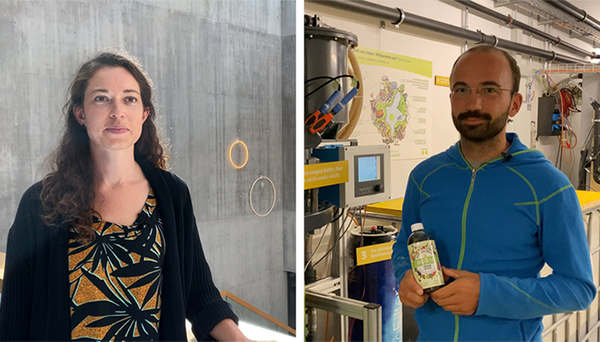News Detail
"Wastewater is a source of nutrients, energy and water"
September 29, 2020 |
Nowadays circular economy mostly concerns the recycling of materials and raw materials. However, closing cycles also holds enormous potential in other areas - and in some cases, we are already much further than conventional recycling. The wastewater research at Eawag has been focusing on how to separate wastewater streams at their source, how to treat as well as how to reuse them as efficiently as possible for 25 years. The guiding principle: Wastewater is not waste, but a valuable resource.
From waste to resource
Today, mixed wastewater is transported to the sewage treatment plant, where it is extensively purified and the treated water is finally discharged into the waterways. This brings along some challenges. For example, treatment in the sewage plant requires energy and space. In addition, the wastewater contains valuable nutrients. By separating the wastewater streams at the source, it is possible to treat them separately and, among other things, to recycle the nutrients in the sense of a circular economy.
"Wastewater contains many valuable resources. For example, urine contains large quantities of nitrogen and phosphorus, which can be recycled as plant fertilizer. In addition, wastewater can also serve as a source of energy and water," says Carina Doll, Project Coordinator at Eawag. Grey water, from showers and washbasins for instance, can be treated to retrieve water. Depending on local needs, this water can be used for various purposes, such as irrigation, flushing toilets or, with appropriate treatment, even for showering. Feces from brown water - the wastewater from the toilet from which urine has been separated - can be processed into pellets. When burning these pellets, energy is recovered in the form of heat.
Efficient circular economy at NEST
At NEST's Water Hub, Eawag and the company Vuna are conducting research into resource-oriented, decentralized wastewater treatment. One important piece of the puzzle is a urine separation toilet that separates the streams at source - i.e. urine from the rest of the wastewater. This is where the NEST partner Keramik Laufen comes into play. After the traditional Swiss company had already installed one of its new "Save!" toilets at NEST at the end of 2019, this year the entire building has been equipped. "With the installation of our 'Save! Toilets' at NEST, we achieve a highly efficient circular economy for the building and further advance the research in this area", says Rolf Schmidt, Head of Marketing at Keramik Laufen AG.
The innovative toilet separates the urine from the flushing water completely without mechanics and sensors. The underlying trick is the urine trap, which is based on the so-called "teapot effect". The urine flows along the ceramic edge into a separate urine opening. The faster-flowing flush water, on the other hand, overflows this edge and transports feces and toilet paper away, as is the case with conventional toilets. The special design that makes this possible was created by the designer Harald Gründl and his team from the Austrian company EOOS Design.
Fertilizer that closes the loop
At NEST, the wastewater streams are finally separated and fed into the Water Hub via separate pipes. One of the streams is particularly important for Vuna: urine. The Eawag spin-off uses a process in the Water Hub that enables the valuable nutrients in the urine to be reused.
First, the urine is stabilized by nitrification. During this process, the ammonium is biologically converted into nitrate, which eliminates the unpleasant odor. Then an activated carbon filter removes drugs and hormones. Finally, the liquid is evaporated. This eliminates germs and reduces the volume. The result: water and Vuna's liquid fertilizer Aurin.
"Separately collected urine is a very rich source of nutrients. Thanks to our treatment process, our fertilizer contains all the important nutrients that plants need to grow. Aurin is also the first urine fertilizer in the world to be granted a state permit for use on edible plants," says Bastian Etter, Managing Director of Vuna GmbH.
Thanks to the cooperation between research and industry, the urine recycling loop is now complete. Of course, there are also other processes for the reuse of the remaining wastewater streams. But more about this in another success story.
Cover picture: Loris Padiani, Empa

